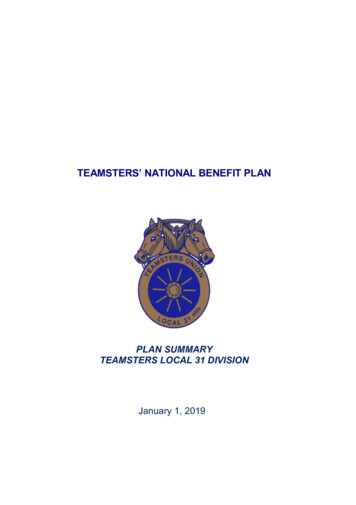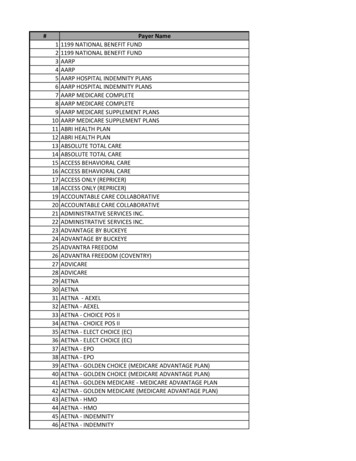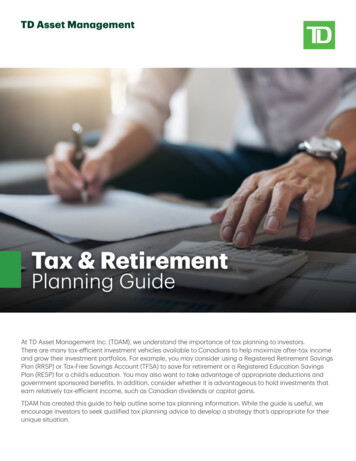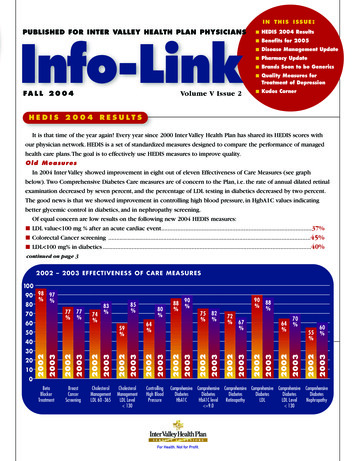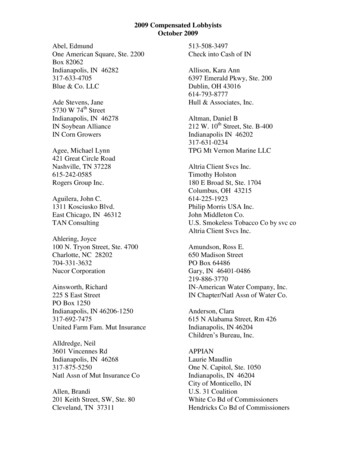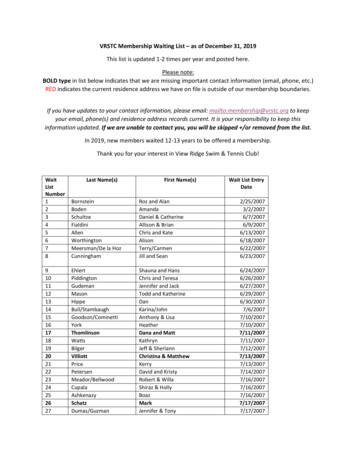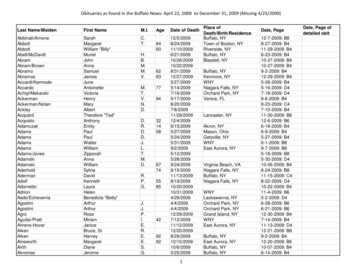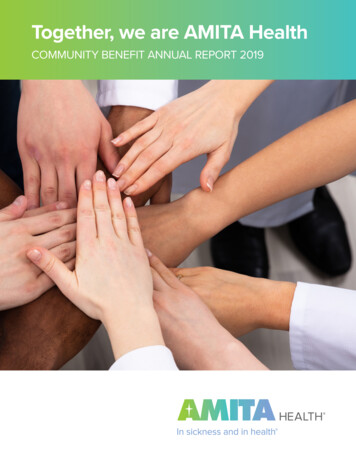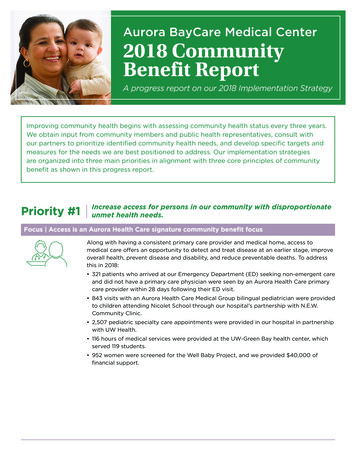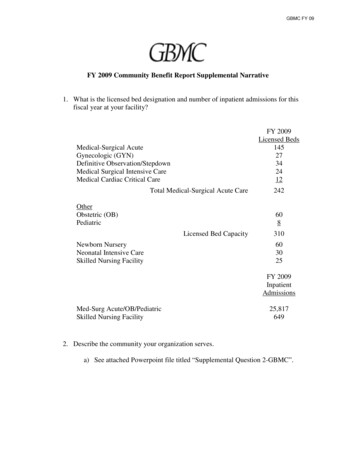
Transcription
GBMC FY 09FY 2009 Community Benefit Report Supplemental Narrative1. What is the licensed bed designation and number of inpatient admissions for thisfiscal year at your facility?FY 2009Licensed Beds14527342412Medical-Surgical AcuteGynecologic (GYN)Definitive Observation/StepdownMedical Surgical Intensive CareMedical Cardiac Critical CareTotal Medical-Surgical Acute CareOtherObstetric (OB)Pediatric242608Licensed Bed CapacityNewborn NurseryNeonatal Intensive CareSkilled Nursing Facility310603025FY 2009InpatientAdmissionsMed-Surg Acute/OB/PediatricSkilled Nursing Facility25,8176492. Describe the community your organization serves.a) See attached Powerpoint file titled “Supplemental Question 2-GBMC”.
GBMC FY 09Supplemental Question#2Information Regarding the Community Servedby Greater Baltimore Medical Center
GBMC’s & It’s CommunityGBMC FY 09 Greater Baltimore Medical Center, Inc. (“GBMC”) is a private, not-for-profit, 310bed, regional medical center. Located in Towson, Maryland, a suburban Baltimore County community two milesnorth of Baltimore City. GBMC’s primary service area includes all of Baltimore County, the northern portionof Baltimore City, and portions of Carroll and Harford Counties. In 2008, Baltimore County had an estimated population of 785,618. The population in GBMC’s service area has traditionally been affluent.-Baltimore County ranked 2nd among MD counties for the highest income per capita in 2007.-The 2007 per capita income in Baltimore County was 34% high than the nation.- But,in 2007 Baltimore County had: 8% of the population in poverty 9% of related children under 18 were below the poverty level 8% of people 65 years old were below the poverty line 5% of all families lived in poverty 14 % of families with a female householder and no husband present had incomes below the poverty level In FY 2009GBMC’s service area patients were 1.47% self-pay and 5.26% Medicaid. GBMC’s patients in FY 2009, were 1.9% self-pay and 5.1% Medicaid.
GBMC Eight Market ZonesGBMC FY 09
GBMC FY 09MD Healthcare CommissionNOTE:This survey focuses on Maryland’s nonelderly (under age 65) population because nearly all of the elderly are covered by Medicare.
MD Healthcare CommissionGBMC FY 09NOTE:This survey focuses on Maryland’s nonelderly (under age 65) population because nearly all of the elderly are covered by Medicare.
GBMC FY 09Maryland Medically UnderservedGBMC Market Zone
GBMC FY 09GBMCFY08 / 09 RevenueSub-Total Self Pay / MedicaidPrimary Insurance Group FY08 Total Gross Rev % Total FY09 Total Gross Rev % TotalSelf PayMedicaidMedicaid PendingMCOSub 369,975,103100.0%404,287,998100.0%
GBMC FY 093. Identification of community needs:a) Describe the process used by your hospital for the health needs in yourcommunity, including the date when most recently compiled.During fiscal year 2006 the Greater Baltimore Medical Center (GBMC)Community Needs Advisory Committee compiled a GAP assessmentdesigned to evaluate and understand the unmet healthcare needs of theGBMC community, and how GBMC, given its service orientation, mightbe best served to assist in meeting the identified unmet needs.Because Baltimore County has not prepared a formal community needsassessment, GBMC borrowed statistical and medical incidence data fromthe 2004 Carroll County community needs assessment, as well as variousother national data.b) In seeking information regarding community health needs, did you consultthe local health department?During preparation of the GAP assessment, GBMC contacted theBaltimore County department of health regarding the use of a county-wideneeds assessment and was informed that the county did not compile suchan assessment. However, GBMC, in order to update the fiscal year 2006GAP assessment, recently met with the Baltimore County Department ofHealth and Department of Aging. While a formal community needsassessment is still not prepared for the county, statistical incidenceinformation on select disease categories can be provided by the CountyHealth Department. The purpose of the meeting is to establish acooperative relationship with the County Health Department and seekinformation to ensure that GBMC’s community initiatives are focused onareas of unmet community need.4. Please list the major needs identified through the process explained in question#3.a) Obesity/Weight-Management – focuses on growing incidence of inactivelifestyles and diet management, which when not managed properly lead tosignificant increases in diabetes, obesity and other health related issues.b) Obstetrics/Gynecology – centers primarily on the sexual behavior ofadolescents and associated teenage pregnancy rates.c) Geriatrics – addresses the increasing percentage of the population aged 65years and older, including the increased percentage living at or belowfederal poverty guidelines. This particular population is challenged
GBMC FY 09regarding access to primary care services due to transportation as well ashealth related issues. By not properly accessing care at a primary, orpreventive stage, this population often presents to healthcare providerswith advanced disease conditions.5. Who was involved in the decision making process of determining which needs inthe community would be addressed through community benefits activities of yourhospital? GBMC maintains a inter-disciplinary Community Needs AdvisoryCommittee, with representation from Outreach Services, Compliance,Finance, Legal and other clinic based areas, which meets monthly toevaluate, debate and approve community based initiatives. In addition, theCommittee reports directly to the President & Chief Executive Officer andalso maintains two Board members as members of the Committee.6. Do any major Community Benefit program initiatives address the needs listed in#4, and if so, how?a) Geriatric Nurse Practitioner – GBMC hired a nurse practitioner whose soleresponsibility is to provide education and primary care services (physicalhistory, medication management assistance, blood pressure screenings andseasonal vaccinations) at Towson area low-income senior living facilities.This was a service that had at one-time been provided by BaltimoreCounty, but was discontinued a number of years ago.b) American Diabetes Association (ADA) Partnership – Over the last threeyears GBMC has contributed 50,000 to the ADA Youth II diabetesinitiative. The program is designed to enroll qualifying participants intargeted geographic regions of Baltimore County and Baltimore City.Once enrolled, the participants are provided information and access toresources designed to improve daily routines, specifically diet andexercise.7. Please provide a description of any efforts taken to evaluate or assess theeffectiveness of major community benefit program initiatives. The recent major initiatives undertaken by GBMC and described in theanswer to question #6 have not yet been evaluated. Specifically, it wasrecognized that each of these programs would take a period of time tobuild volume and start to incur measurable and quantifiable results.Nonetheless, an element of each initiative is the tracking of encounterdata, and in the case of the Geriatric Nurse Practitioner the type of servicesprovided, to evaluate the effectiveness of each program to determine ifcontinued funding is desirable.
GBMC FY 098. Provide a written description of gaps in availability of specialist providers,including outpatient specialty care, to serve the uninsured cared for by thehospital. As noted in previous years, GBMC continues to experience difficulty inproviding anesthesia, obstetrical, and orthopedic services to Medicaid anduninsured patient populations.9. If you list physician subsidies in your data, please provide detail. GBMC owns and operates a physician practice that is committing toensuring all patients have appropriate access to OB/GYN care.Accordingly, the practice operates with an annual loss due primarily to itsprovision of care to medically underserved patients. The annual operatingloss is claimed as a community benefit.
GBMC FY 09Appendix 1FY 2009 Community Benefit Report FilingDescription of Financial Assistance PolicyGBMC has taken significant measures to ensure that its Financial Assistance Policy isboth visible and accessible to patients by enacting the following measures:1. Availability of Applications & Brochures Via websiteAll hospital patient registration areas; including admitting, emergencydepartment, laboratory stations, clinics and radiology servicesGBMC owned physician officesBilling OfficeIncluded in each billing statement to patientIn addition, to the availability of applications and brochures, signs describing theexistence of a Financial Assistance Policy and opportunity for financial assistance arealso prominently displayed throughout the hospital.2. Direct AssistanceUtilizing the admitting and insurance verification process, prior to discharge, thePatient Financial Services department attempts to assist many patients with financialevaluations in order to determine the availability for financial assistance and/orqualifying insurance coverage. In addition, during the account resolution process,staff is also trained to evaluate a patient’s unique circumstances and attempt to directpatients to financial assistance when appropriate.GBMC will also assist patients in enrolling for State Medical Assistance coverage.3. EducationTo ensure that employees are qualified to direct patients in accessing financialassistance, new employees and volunteers are specifically educated during new-hireorientation programs on how to obtain financial assistance applications andbrochures.
GBMC FY 09Appendix 2Greater Baltimore Medical CenterPatient Financial Assistance ServicesFinancial Assistance PolicyI.PURPOSETo establish guidelines assuring consistency in the implementation of the FinancialAssistance Program.II.POLICYGBMC recognizes its obligation to the communities it serves to provide medicallynecessary care to individuals who are unable to pay for medical services regardless ofrace, color, creed, religion, gender, national origin, age, marital status, family status,handicap, military status, or other discriminatory factors.The Financial Assistance procedures are designed to assist uninsured individuals orindividuals who qualify for less than full coverage under federal, state or local programs,or individuals whose patient balances after insurance exceed their ability to pay.While flexibility in applying guidelines to an individual patient’s situation is clearlyneeded, certain objective criteria are essential to assure consistency in theimplementation of the Financial Assistance Program.A.B.Eligible/Ineligible Services1.Services considered medically necessary are covered under the program2.Services considered elective (i.e. cosmetic) are not covered under theprogram unless directly to related or part of a medically necessary procedure3.Applicants meeting eligibility criteria for Federal Medicaid must apply andbe determined ineligible prior to Financial Assistance considerationReferral Sources1.Financial Assistance referrals will generally originate in the InsuranceVerification, Advocacy and Collection/Insurance departments accompaniedwith a Financial Evaluation (Attachment #1) and Medical AssistanceEligibility Check List (Attachment #1a)2.Other referral sources include social services, physician offices,administration, etc.3.GBMC recognizes the importance of communicating the availability of theRevised 4/1/20101
GBMC FY 09Financial Assistance Program to all patientsC.D.a.The Financial Assistance Application and brochures explainingthe program are located on the GBMC websiteb.Brochures and applications are available in all GBMC ownedphysician offices and in all hospital registration areasc.All new employees and volunteers are educated during theirorientation programs with regard to the Financial Assistance Programand how to assist patients in obtaining applications and brochuresFinancial Eligibility Criteria1.Eligibility is based on gross household income2.Gross household income is defined as wages and salaries from all sourcesbefore deductions3.Other financial information such as liquid assets and liabilities are considered4.Annual household income criteria is 300% of the current poverty guidelinespublished in the Federal Register5.Applicants that exceed established household income levels may still beeligible when additional factors such as disposable net income are considered(See “Financial Assistance When Gross Household Income Is Greater Than300% Poverty Guidelines”)Household Income1.Revised 4/1/2010Household Income to be considereda.All wages and salariesb.Social Security, veteran’s benefits, pension plans, unemployment andworker’s compensation, trust payments, child support, alimony, publicassistance, strike benefits, union funds, income from rent, interest anddividends or other regular support from any person living in the homec.Generally, the availability of liquid assets including cash,checking/savings account balances, certificates of deposit, stocks,bonds, money market funds, etc. exceeding 2 months of livingexpenses will be considered (referred to in the policy as LiquidAssets)2
GBMC FY 09d.2.E.Based on individual circumstances, allowances can be made to haveliquid assets exceed the two month test up to 25,000Proof of Household Income (Attachment #2)a.One or more of the following items may be requested from theapplicant to verify income for each income producing member of thehousehold. Monthly household income is prorated to determine annualhousehold income level.b.Two recent pay stubs reflecting year-to-date earnings for each familymember who is a guarantor or could be deemed responsible for theaccount.c.Most recent income tax return(s) with W2sd.Social Security Award Letter(s)e.Most recent unemployment insurance stubf.Two most recent checking and savings account statementsg.Two most recent investment statements (money market, CD, stocks,etc.)h.Letter from federal, state or local agency verifying the amount ofassistance awardedi.Applicants claiming zero household income must supply proof of howtheir living expenses are paid with a notarized letter of support.Cancelled checks and/or receipts may also be required if anotherindividual is paying patient’s billsj.Medical Assistance denial or spend-down determination letterk.Identified asset transfers within a 12 month period of application maybe factored into determining eligibility.l.Other pertinent household income verification documentation asrequiredExpenses1.Revised 4/1/2010Expenses to be considered (also see “Questionable Expenses” under“Financial Assistance When Gross Household Income Is Greater Than 300%Poverty Guidelines”)3
GBMC FY 092.All reasonable living expenses (mortgage/rent, utilities and loan/credit cardpayments)a.Either land-line telephone or cell phone bill will be considered (notboth)c.A monthly car payment of up to 450 for one car is allowedThe maximum allowance per family (2 adults) is 900Any amount over the above allowance will be considered within themiscellaneous allowanced.Payments for recreational items such as boats, motorcycles, etc. arenot allowable expenses Exception: if motorcycle is only source oftransportatione.Expenses for Cable TV, Dish TV and/or Internet are considered withinthe miscellaneous allowancef.Expenses for second homes are not allowable expenses (however,income from rental properties will be counted as Household Income)g. 150 food allowance will be given for patient; and 75 food allowancefor each additional family memberh. 300 miscellaneous allowance will be given for ancillary livingexpenses (i.e.: gas for automobile, grooming items, automobilemaintenance, tuition and tithing)3. Medical expensesIII.1.Up to 100 in prescription expenses per person will be consideredwithout receipts2.Prescription expenses that exceed 100 per person cannot be consideredunless patient provides receipts for the two prior months3.Medical expenses are considered upon proof from patient of activepayment arrangementsPROCEDURESA.Application Process1.Patients may request Financial Assistance prior to treatment or after billinga.Revised 4/1/2010A new application must be completed for each new course of treatmentwith the following exceptions:4
GBMC FY 09Inpatient and outpatient Medicare patients are certified for one year (see“Medicare Patients”)Inpatient and outpatient non-Medicare patients are certified for 6months. However, if it is determined during the course of that periodthat the patient meets Medical Assistance eligibility criteria they arerequired to pursue Medicaid prior to receiving additional FinancialAssistanceMitigating circumstances impacting eligibility period are identified.(examples include favorable changes in the applicants income, winninga lottery, receiving notable inheritance, etc.) These determinations aremade at the discretion of the Collection Manager and/or Director ofPatient Financial Services.3.At the time of application all open accounts are eligible for considerationwith the potential exception of patients who are in bad debt status and did notrespond to collection activity or statements prior to write-off of account(s)4.The signed/completed Financial Evaluation is referred to the FinancialAssistance Departmenta.Combined account balance(s) greater that 2,5001. Completed Financial Evaluation2. Proof of household income3. Credit bureau report obtained and reviewed to verify information,develop additional sources for funds and utilized as a collection toolfoundb.c.B.Combined account balance(s) less than 2,5001.Completed Financial Evaluation2.Proof of household income3.Credit bureau report may be obtained and reviewed if householdincome and/or household expense discrepancies are foundAccounts are approved or denied based on household income criteriaand applicant cooperationHousehold Income Criteria for Financial Assistance Approval / DenialRevised 4/1/20105
GBMC FY 091.2.Combined gross household income less than 300% of the poverty guidelinesa.Applicants are eligible for 100% Financial Assistanceb.However, applicants with liquid assets including cash,checking/savings account balances, certificates of deposit, stocks,bonds, money market funds, etc., not exceeding 25,000, who meet theincome eligibility requirements, will be considered for assistance at thediscretion of the Director of Patient Financial Services and/or theFinancial Assistance Committee. Inability to replenish the resourceand/or current usage of the resource to cover allowed living expensesmay qualify the applicant for assistance.c.Applicants with liquid assets (described above) exceeding 25,000, maynot qualify for assistance. However, at the discretion of the ChiefFinancial Officer, inability to replenish the resource and/or current usageof the resource to cover allowed living expenses may qualify theapplicant for full or partial assistanceCombined gross household income greater than 300% of the povertyguidelines and the patient is still unable to make acceptable paymentarrangements (minimum - 25 per month)a.C.Applicants are reviewed on a case-by-case basis (see “FinancialAssistance When Gross Household Income Is Greater Than 300%Poverty Guidelines”)Financial Assistance When Gross Household Income Is Greater Than 300%Poverty Guidelines1.Applicants whose gross household income exceeds 300% of the povertyguidelines but state they are still unable to pay all or part of their accountbalance(s) may be further evaluated for Financial Assistance2.In these cases, consideration is given to expenses, disposable net householdincome, total liquid assets and account balance(s)3.Disposable net income is defined as gross household income less deductionsand expenses (Program allows 250 disposable income for one person and 75 for each additional family member.) Disposable income (exceeding 250for one person and 75 for each additional family member) will be used todetermine patient’s ability to pay)a.The applicant is required to supply proof of “questionable” expenses1.Revised 4/1/2010“Questionable” expenses are defined as any expense item thatappears to be overstated/understated and/or not reasonable or6
GBMC FY 09customaryb. A credit bureau report is required to evaluate the application (regardlessof account balance)c. Patients whose disposable income is within the limits stated above andwhose liquid assets do not exceed the standard (See Household Income);are eligible for 100% Financial Assistanced. Patients who exceed the asset standard (See Household Income) areineligible for Financial Assistance and need to make paymentarrangements (See Resource Payment Arrangements)e. Eligibility for patients who have excess disposable income is determinedbased on ability to satisfy outstanding balance(s) within timeframedefined (See Financial Assistance With Resource) All exceptions will bereviewed by the Director of Patient Financial Services4. Applicants approved for 100% Financial Assistance (See “ProcessingApproved Applications”)D.Financial Assistance With Resource1.Resource amounts are determined based on the applicant’s ability to pay aportion of their account balance(s) without causing undue financial hardship \using the following guidelines2. Outstanding balance(s) owed to GBMC are divided by excess disposableincome to determine the number of months needed to pay the outstandingbalance(s) in full3.Excess disposable income determines the amount of the monthly payment(See Resource Payment Arrangements for standards)4.Outstanding balance(s) that cannot be satisfied within 24 months will bereduced by the difference between the total outstanding balance(s) and thetotal required patient payment amount (excess disposable income multipliedtimes 24 months)5.All resource amounts are reviewed and approved by the Director andCollection Manager6.Approval processa.Revised 4/1/2010The completed Financial Evaluation (including resourcerecommendation), Authorization Form (Attachment #3) anddocumentation is forwarded to the Collection Manager7
GBMC FY 09b. The Collection Manager will ensure that all required authorizationsignatures are obtained7.When authorization is obtained the patient is mailed a Financial AssistanceReduction Letter (Attachment #6) and a Financial Assistance PromissoryNote (Attachment #6A) outlining the terms and conditions of the agreement8.The Financial Assistance Promissory Note must be returned within 14days. Failure to do so may result in the patient’s ineligibility for FinancialAssistancea. Signed promissory notes are forwarded to the Collection Manager (see“Processing Approved Applications”)E.Resource Payment Arrangements1.Resource payment arrangements will not exceed 24 monthsa. Every effort is made to liquidate the resource amount within the earliestpossible time frame2.The minimum monthly payment amount is 25a. Patient is set up under a contract in Meditech with an alert on PatientOverview screen (alert is set to remind collector that partial write-offoccurred in the event of patient default on resource payments)b. Patients are automatically sent monthly statements through Meditechindicating their monthly payment amount, due date and accountbalance(s)4.If a patient qualifies for Financial Assistance with a resource and hasmultiple account balances, all account balances are allowanced leaving onlyone open account (if possible) for the resource amounta. A weekly Meditech work list is reviewed to determine if patients aredelinquent with their paymentsb. Failure to pay as agreed will result in the patient being responsible forboth the allowance amount and the unpaid resource balancec. Forward the delinquent account to the Collection Managerd. The Collection Manager/ or designee reverses the Financial AssistanceallowanceRevised 4/1/20108
GBMC FY 09e. Patient is sent a final demand letterF.G.Authorization For Financial Assistance 1 - 2,499- Coordinator 2,500 - 5,000- Collection Manager 5,001 - 10,000- Director of Patient Financial ServicesGT 10,000- EVP/CFOIncomplete / Uncooperative1.H.Failure to supply required information or to communicate reason for delaywithin 10 days may result in the applicant’s ineligibility for FinancialAssistanceProcessing Approved Applications1.Completed applications are forwarded to the Collection Manager with allappropriate supporting documentation2.The Collection Manager will ensure that each applicant has met householdincome requirements, supplied appropriate supporting documentation andthat proper authorization signatures are obtaineda. The Collection Manager or designee applies the Financial Assistanceadjustment and files the Financial Evaluation, Authorization Form andrelated documentation3. The patient is sent a Financial Assistance Award Letter (Attachment #4)I.Processing Denied Applications1. Applicants that are determined to be ineligible based on household incomeand/or asset criteria are sent a Financial Assistance Denial Letter Attachment#5)2. Patients have the right to appeal denials. Final appeal decisions are at thesole discretion of the next level of required signature authority. (Example –Director of Patient Financial Services to review appeal for CollectionManager level denial)Revised 4/1/20109
GBMC FY 09J.Medicare Patients1.Medicare patients are required to supply a copy of their Social SecurityAward Letter on a yearly basis2.Medicare patients are certified for 1 year. However, if it is determinedduring the course of that year that the patient meets Medical Assistanceeligibility criteria they will be required to pursue Medicaid prior to receivingadditional Financial Assistance3. The Financial Assistance Department will refer Medicare patients meetingMedicaid eligibility criteria to the Advocacy Department for processingK.Medicaid Resources1. Medicaid resources are automatically reviewed for Financial Assistancewhen a copy of the Department of Social Services (DSS) 0102 Form(Attachment #7) is supplied to the Financial Assistance Department2. DSS income calculations and Financial Assistance program allowances areused to calculate patient’s disposable income (see “Gross Household IncomeIs Greater Than 300% Poverty Guidelines”)L.Recurring Accounts1. Patients are certified 6 months for Non Medicare and 1 year for Medicare.Based on each unique situation, these periods may be extended at thediscretion of the Director of Patient Financial Services.2. If patients are admitted or start a new course of treatment, they are screenedfor Medicaid and/or reevaluated for Financial AssistanceM.Financial Assistance Statistical Reporting1.IV.The Collection Manager or designee is responsible for completing allmonthly and year-to-date statistical analysis as required.ASSUMPTIVE FINANCIAL ASSISTANCEAssumptive Financial Assistance is a program run in partnership with TransUnion creditreporting agency. Self-pay Emergency Department cases are referred to TransUnion,who utilizes a proprietary credit scoring system to determine likelihood of ability to paybased on estimated income and family size. The results from the TransUnion creditscoring are compared to GBMC’s Financial Assistance eligibility criteria and a decisionis made to write off or to pursue collection.Revised 4/1/201010
GBMC FY 09A.V.Eligible/Ineligible Services1.Only bills for uninsured patients for services incurred in the EmergencyDepartment are eligible for Assumptive Financial Assistance screening atthis time2.Patients seen in the Emergency Department as the result of a motor vehicleaccident or for which any third party liability may exist will not beconsidered under the Assumptive Financial Assistance program3.Uninsured patients seen in the Emergency Department under EmergencyPetition will not be condisered under the Assumptive Financial Assistanceprogram until the Maryland Medicaid Psych program (MAPS) has beenbilledPROCESSES UTILIZED BY TRANSUNION TO DETERMINE ELIGIBILITY STATUSA.TransUnion accesses credit data, via the Healthcare Revenue Cycle Platform(HRCP). TransUnion built and maintains a proprietary matching algorithm toselect consumer credit files, including data like; name, address, SSN, Soundex andother criteria to match input inquiries to the correct credit file. This algorithm isused to match hundreds of millions of credit inquiry requests each year. It isconstantly reviewed and maintained to provide accurate credit data to tens ofthousands of customers. The minimum customer input requirement is name and \address. TransUnion also accepts, SSN, previous address and date of birth inputas part of its matching algorithm. HRCP then employs proprietary algorithms andexpert business rules to match each hospital’s own charitable, regulatoryguidelines and policies to patient qualifications.B.HRCP employs a proprietary algorithm to estimate minimum family income andsize. The algorithm uses information like debt to income ratios, current financialobligations that are being met, residual income for household members and cost ofliving calculations to estimate the minimum monthly income. HRCP alsoestimates family size based upon data such as, joint credit accounts, authorizedusers of credit cards, etc. The algorithm calculates FPL based upon these data.Customers may evaluate and configure certain parts of the algorithm like residualincome to level the estimates for cost of living differences in geographic areas.C.Under the Fair Credit Reporting Act (FCRA) and other privacy regulations,TransUnion cannot disclose financial information regarding individual consumersto anyone without satisfying permissible purpose requirements.D.The HRCP proprietary algorithm used for estimating FPL (minimum estimatedfamily income and size) uses both credit dat
Located in Towson, Maryland, a suburban Baltimore County community two miles north of Baltimore City. GBMC's primary service area includes all of Baltimore County, the northern portion of Baltimore City, and portions of Carroll and Harford Counties. In 2008, Baltimore County had an estimated population of 785,618.
